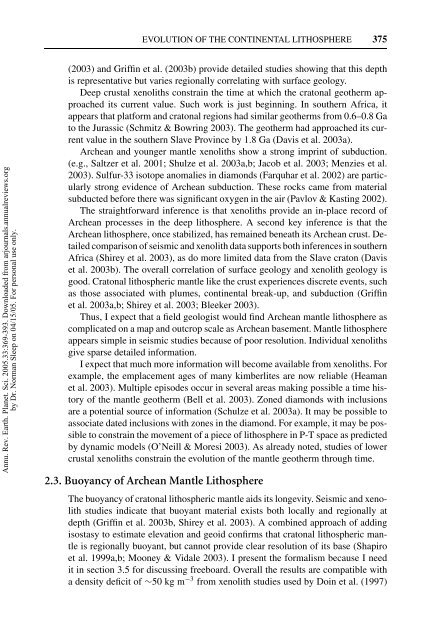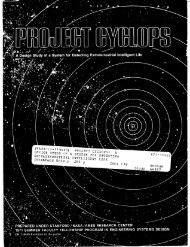evolution of the continental lithosphere - Department of Earth and ...
evolution of the continental lithosphere - Department of Earth and ...
evolution of the continental lithosphere - Department of Earth and ...
You also want an ePaper? Increase the reach of your titles
YUMPU automatically turns print PDFs into web optimized ePapers that Google loves.
EVOLUTION OF THE CONTINENTAL LITHOSPHERE 375<br />
Annu. Rev. <strong>Earth</strong>. Planet. Sci. 2005.33:369-393. Downloaded from arjournals.annualreviews.org<br />
by Dr. Norman Sleep on 04/15/05. For personal use only.<br />
(2003) <strong>and</strong> Griffin et al. (2003b) provide detailed studies showing that this depth<br />
is representative but varies regionally correlating with surface geology.<br />
Deep crustal xenoliths constrain <strong>the</strong> time at which <strong>the</strong> cratonal geo<strong>the</strong>rm approached<br />
its current value. Such work is just beginning. In sou<strong>the</strong>rn Africa, it<br />
appears that platform <strong>and</strong> cratonal regions had similar geo<strong>the</strong>rms from 0.6–0.8 Ga<br />
to <strong>the</strong> Jurassic (Schmitz & Bowring 2003). The geo<strong>the</strong>rm had approached its current<br />
value in <strong>the</strong> sou<strong>the</strong>rn Slave Province by 1.8 Ga (Davis et al. 2003a).<br />
Archean <strong>and</strong> younger mantle xenoliths show a strong imprint <strong>of</strong> subduction.<br />
(e.g., Saltzer et al. 2001; Shulze et al. 2003a,b; Jacob et al. 2003; Menzies et al.<br />
2003). Sulfur-33 isotope anomalies in diamonds (Farquhar et al. 2002) are particularly<br />
strong evidence <strong>of</strong> Archean subduction. These rocks came from material<br />
subducted before <strong>the</strong>re was significant oxygen in <strong>the</strong> air (Pavlov & Kasting 2002).<br />
The straightforward inference is that xenoliths provide an in-place record <strong>of</strong><br />
Archean processes in <strong>the</strong> deep <strong>lithosphere</strong>. A second key inference is that <strong>the</strong><br />
Archean <strong>lithosphere</strong>, once stabilized, has remained beneath its Archean crust. Detailed<br />
comparison <strong>of</strong> seismic <strong>and</strong> xenolith data supports both inferences in sou<strong>the</strong>rn<br />
Africa (Shirey et al. 2003), as do more limited data from <strong>the</strong> Slave craton (Davis<br />
et al. 2003b). The overall correlation <strong>of</strong> surface geology <strong>and</strong> xenolith geology is<br />
good. Cratonal lithospheric mantle like <strong>the</strong> crust experiences discrete events, such<br />
as those associated with plumes, <strong>continental</strong> break-up, <strong>and</strong> subduction (Griffin<br />
et al. 2003a,b; Shirey et al. 2003; Bleeker 2003).<br />
Thus, I expect that a field geologist would find Archean mantle <strong>lithosphere</strong> as<br />
complicated on a map <strong>and</strong> outcrop scale as Archean basement. Mantle <strong>lithosphere</strong><br />
appears simple in seismic studies because <strong>of</strong> poor resolution. Individual xenoliths<br />
give sparse detailed information.<br />
Iexpect that much more information will become available from xenoliths. For<br />
example, <strong>the</strong> emplacement ages <strong>of</strong> many kimberlites are now reliable (Heaman<br />
et al. 2003). Multiple episodes occur in several areas making possible a time history<br />
<strong>of</strong> <strong>the</strong> mantle geo<strong>the</strong>rm (Bell et al. 2003). Zoned diamonds with inclusions<br />
are a potential source <strong>of</strong> information (Schulze et al. 2003a). It may be possible to<br />
associate dated inclusions with zones in <strong>the</strong> diamond. For example, it may be possible<br />
to constrain <strong>the</strong> movement <strong>of</strong> a piece <strong>of</strong> <strong>lithosphere</strong> in P-T space as predicted<br />
by dynamic models (O’Neill & Moresi 2003). As already noted, studies <strong>of</strong> lower<br />
crustal xenoliths constrain <strong>the</strong> <strong>evolution</strong> <strong>of</strong> <strong>the</strong> mantle geo<strong>the</strong>rm through time.<br />
2.3. Buoyancy <strong>of</strong> Archean Mantle Lithosphere<br />
The buoyancy <strong>of</strong> cratonal lithospheric mantle aids its longevity. Seismic <strong>and</strong> xenolith<br />
studies indicate that buoyant material exists both locally <strong>and</strong> regionally at<br />
depth (Griffin et al. 2003b, Shirey et al. 2003). A combined approach <strong>of</strong> adding<br />
isostasy to estimate elevation <strong>and</strong> geoid confirms that cratonal lithospheric mantle<br />
is regionally buoyant, but cannot provide clear resolution <strong>of</strong> its base (Shapiro<br />
et al. 1999a,b; Mooney & Vidale 2003). I present <strong>the</strong> formalism because I need<br />
it in section 3.5 for discussing freeboard. Overall <strong>the</strong> results are compatible with<br />
a density deficit <strong>of</strong> ∼50 kg m −3 from xenolith studies used by Doin et al. (1997)













